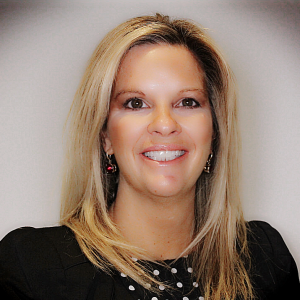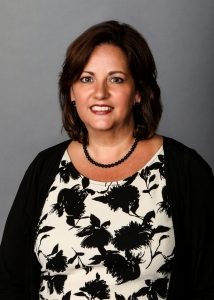Our Spotlight on Flex showcases professionals from member organizations who exemplify personal and professional success while working a flexible schedule. Their stories illustrate the long-term benefits that flexible schedules offer to both individuals and organizations.
May 2020 Spotlight on Flex
 For May 2020, we are pleased to share insights from Heather Wenzel, Partner, Morgan Lewis (Hartford, CT)
For May 2020, we are pleased to share insights from Heather Wenzel, Partner, Morgan Lewis (Hartford, CT)
Diversity & Flexibility Alliance: How have you made flexibility a priority and a success with your schedule?
Heather Wenzel: After graduating from law school in 2005, I started working at a large Connecticut based law firm. But a year in, I realized it was not a good fit. A recruiter called me to interview at what was at the time Bingham McCutchen. The interview process went well, and I started working there in 2007. Since then, Bingham McCutchen combined with Morgan Lewis, and that combined firm is where I have worked ever since – 13 years! I made partner in 2019, and looking back, without flexible work, I would not have had the same success and career trajectory, especially after having kids.
I had premature twins in 2014 (a boy and a girl), and they spent the first months of their lives in the NICU. My leave time was not traditional; I wasn’t at home with my newborns, and I knew I needed more time to spend with them. I was already planning to take six months of leave before they arrived early, and my partners were extremely supportive when I needed to extend that time to account for the unforeseen NICU stay. They knew with twins, I was going to be jumping head first into the fire. Flexible work was not only on my mind, it was essential for me in order to stay at the firm.
When I returned from leave, my babies were eight months old. Morgan Lewis never hesitated to show their support for me and for flexible work. I came back at an 80% reduced hours schedule with five days in the office. I left at 5 pm and signed back on at night as necessary. It was such a relief to be able to leave at 5 pm without feeling guilty. I’ve been on this schedule for the past six years, and it’s what’s allowed me to stay in big law. Morgan Lewis also instituted a remote work program which gave me more flexibility to work one-two days a week at home. As a working mother with twins, or any working professional for that matter, this extra layer of flexibility is huge. My standard schedule now allows me to work one day a week at home in addition to my reduced hours. It’s been perfect and also prepared me for our current complete remote-work situation due to COVID-19.
A lot of firms say they support flexibility and that choosing this type of schedule won’t affect your career advancement. But I think there aren’t as many firms that actually support that mentality. Fortunately for me, Morgan Lewis isn’t that type of firm; I was working 80% reduced hours and one day a week at home when I made partner. The firm really stands behind what it says. If I had to be full time, I would not have been able to stay in big law. Nothing takes precedence over my family, and I will always choose them over my job. But at the same time, I love what I do, and flexible work lets me not have to choose between the two.
I’m doing what I want to do as a working mother, and I can still be present for my family when I’m home. It’s not about being in the office from 9-5; it’s about being there for your family when I want and need to be there. Deals are finished, clients are ecstatic, and they never know that I’m working outside of the traditional 9-5 work day.
DFA: How have the firm and/or clients contributed to your Flex Success®?
HW: When I started at the firm in 2007, I was a member of the American College of Investment Counsel (ACIC). Twice a year, all the outside and in house counsel came together for their annual meetings. The demographic was quite different at the time; I was one of the few, younger female attorney members in a room full of partners and in house counsel who were mostly men. Now the demographics in finance have changed. I see more women in the room and more working moms. All this to say that the demographics of my clientele have changed over the years too. My clients are dealing with the same work-life control issues that I am. The depth of understanding and shared experiences have evolved and made my client relationships stronger.
With more clients experiencing the same issues I am, it alleviates some of the pressure I feel as a partner to be “on” 24/7. I can still provide excellent client service but in an environment and methodology that’s outside of the normal 9-5 work day.
When I first started at the firm, I worked for five male partners, and I established certain boundaries when it came to being present for my family. They realized my work was getting done, clients trusted me, and I was always responsive. I proved myself so it was easier for them to be flexible with me too. I won’t claim that it was always easy, but I give a huge amount of recognition to my team and partners for progressing with me over the years.
DFA: How has working flexibly made your career more sustainable and contributed to business/professional development opportunities?
HW: I’ve always said I’m 80% in hours, but 100% in firm citizenship. The days are gone where you can sit in your office and bank on the phone ringing from your client of 30 years. Ever since I was a mid-level associate, I made marketing a huge part of my professional development. It’s extremely important, and you have to constantly remind your clients that you’re there for them. There are so many other law firms and attorneys out there – we’re easily replaced. Working 80% reduced hours has allowed me to be with my family but also do the client meet and greets, lunches, and presentations.
I personally feel that flexibility is a benefit for the firm on so many levels too; clients want to know that the firms they engage with are diverse, inclusive, and good to working parents. It’s a win for the firm, and it’s a win for me. Morgan Lewis can walk the walk and talk the talk. This in turn benefits the profession as a whole because people hear my success story, and it shows them they can do it too.
DFA: Looking back, would you do anything differently, or what would you tell your younger self?
HW: I would tell myself not to stress so much about it. That’s the biggest thing. I try to tell others that you have to decide what your personal boundaries are going to be. Are you going to be on call 24/7 and that’s your working style? Fine. Or are you going to be someone where Fridays are sacred but you’ll work on Saturdays? Fine too. Set those boundaries. I should have thought about and set my boundaries earlier. Things work out, but I wish I had spent less time worrying about the future.
DFA: How do you recharge, and how do you pay it forward?
I try to recharge through vacation or working out. When I’m active, even if it’s for 30 minutes, I feel more energized for the rest of the day. It’s so hard to be a working parent with young kids; I look back and don’t even know how I did it. I’m trying to be more conscious on paying it forward and understanding that everyone has something going on in their lives. We’re in a high pressure profession, and I know how much flexible work has helped me. We get lost in the mindset that the world will stop moving if we’re not constantly working. But we all know that’s clearly not the case. I’ve never had a deal fall through because I took an hour for myself or put my family first.

 Erin Howell: Ever since I was a junior lawyer, flexibility has always been important to me. I started my career as an insurance regulatory associate at Dewey & LeBoeuf, in 2008 just as the economic downturn hit. The firm started offering partially paid sabbaticals to attorneys. I used that opportunity in 2011 to evaluate my career and figure out what my next steps were going to be. At the time, I had three young step-children, and my sabbatical was a great way to spend time together as a family and figure out my next steps. As you can imagine, working for a firm on the verge of bankruptcy is not pleasant and highly stressful; I wasn’t busy, I wasn’t developing professionally the way I wanted to, and it made me doubt if the practice of law was right for me. It took me the better part of my sabbatical (I used nine months of the allotted 12) to figure out if I wanted to stay in big law or do a complete career overhaul.
Erin Howell: Ever since I was a junior lawyer, flexibility has always been important to me. I started my career as an insurance regulatory associate at Dewey & LeBoeuf, in 2008 just as the economic downturn hit. The firm started offering partially paid sabbaticals to attorneys. I used that opportunity in 2011 to evaluate my career and figure out what my next steps were going to be. At the time, I had three young step-children, and my sabbatical was a great way to spend time together as a family and figure out my next steps. As you can imagine, working for a firm on the verge of bankruptcy is not pleasant and highly stressful; I wasn’t busy, I wasn’t developing professionally the way I wanted to, and it made me doubt if the practice of law was right for me. It took me the better part of my sabbatical (I used nine months of the allotted 12) to figure out if I wanted to stay in big law or do a complete career overhaul. For March 2020, we are pleased to share insights from Kate Saracene Partner,
For March 2020, we are pleased to share insights from Kate Saracene Partner,  MK: Boston Consulting Group (“BCG”) is a dream job for me. I love the impact and variety of our projects and the caliber of our talent. I started as an associate, then consultant to project leader, was promoted to principal, and then again to my current role as a managing director and partner in 2018. BCG has been so supportive every step of my career – between transferring offices twice because of my husband’s career and working at a reduced [hours] capacity. A year into my role as a project leader in 2012, I switched to a flex schedule – this was even before I had kids. I had been at BCG for five years, was traveling extensively, and working a lot of hours. I was at the point where I was jealous of my friends at other jobs who had time during the week (not just the weekends) to do the things they enjoyed. I wanted that option too. But I struggled with how to achieve that work/life control when my colleagues were working more than that. I didn’t think it was fair to change my schedule when the rest of the team was counting on me. I have a background in economics, and after looking at the amount of hours/week I was putting in, I realized the marginal cost to me personally, of each additional hour past 40 hours/week, was a lot higher than the marginal cost of the first 10 hours I worked. I wanted to optimize on the margins; I was willing to give up 20% of my pay in order to shed 20% of the hours that had the highest personal cost to me. In other words, I wanted to work at an 80% capacity by being in the office five days a week, leaving early to be home and have dinner with my husband, and not worry about opening my laptop in the late evening hours. Of course, there were times I had to stay late or meet with clients, but it was an absolute step change in my relationship with managing work and life. I’ll be honest; I didn’t think a reduced schedule was going to work at first. But I needed to make a change. My partners were extremely supportive, clients knew about my schedule change, and BCG put extra resources on my teams so coverage was always in place. I was able to turn down certain projects with confidence that it wouldn’t impede my advancement. In 2013, I had my first child, and I probably would not have come back to work at BCG if I didn’t have flex options in place. I’ve made flex work for me as needed during different stages in my career and life. I was a principal when I had my second child, and I started dividing my time between multiple client projects. But it wasn’t feasible to work five shorter days a week with this arrangement. Instead, I switched to taking one day a week off (either Wednesdays or Thursdays). After my third maternity leave, I went to a 60% reduced capacity schedule and ramped back up to 80% with one day a week off. However in 2018, I took a medical leave of absence; when I returned to work, I went back to 60% reduced capacity, with two days off per week. I’ve been on this schedule ever since. Nothing is set in stone – some weeks I need to switch which days I’m out of the office or some weeks I have to bank my time off for another week. The most important thing is that I work with my team to make sure there’s coverage for our clients. It’s flexible flexibility.
MK: Boston Consulting Group (“BCG”) is a dream job for me. I love the impact and variety of our projects and the caliber of our talent. I started as an associate, then consultant to project leader, was promoted to principal, and then again to my current role as a managing director and partner in 2018. BCG has been so supportive every step of my career – between transferring offices twice because of my husband’s career and working at a reduced [hours] capacity. A year into my role as a project leader in 2012, I switched to a flex schedule – this was even before I had kids. I had been at BCG for five years, was traveling extensively, and working a lot of hours. I was at the point where I was jealous of my friends at other jobs who had time during the week (not just the weekends) to do the things they enjoyed. I wanted that option too. But I struggled with how to achieve that work/life control when my colleagues were working more than that. I didn’t think it was fair to change my schedule when the rest of the team was counting on me. I have a background in economics, and after looking at the amount of hours/week I was putting in, I realized the marginal cost to me personally, of each additional hour past 40 hours/week, was a lot higher than the marginal cost of the first 10 hours I worked. I wanted to optimize on the margins; I was willing to give up 20% of my pay in order to shed 20% of the hours that had the highest personal cost to me. In other words, I wanted to work at an 80% capacity by being in the office five days a week, leaving early to be home and have dinner with my husband, and not worry about opening my laptop in the late evening hours. Of course, there were times I had to stay late or meet with clients, but it was an absolute step change in my relationship with managing work and life. I’ll be honest; I didn’t think a reduced schedule was going to work at first. But I needed to make a change. My partners were extremely supportive, clients knew about my schedule change, and BCG put extra resources on my teams so coverage was always in place. I was able to turn down certain projects with confidence that it wouldn’t impede my advancement. In 2013, I had my first child, and I probably would not have come back to work at BCG if I didn’t have flex options in place. I’ve made flex work for me as needed during different stages in my career and life. I was a principal when I had my second child, and I started dividing my time between multiple client projects. But it wasn’t feasible to work five shorter days a week with this arrangement. Instead, I switched to taking one day a week off (either Wednesdays or Thursdays). After my third maternity leave, I went to a 60% reduced capacity schedule and ramped back up to 80% with one day a week off. However in 2018, I took a medical leave of absence; when I returned to work, I went back to 60% reduced capacity, with two days off per week. I’ve been on this schedule ever since. Nothing is set in stone – some weeks I need to switch which days I’m out of the office or some weeks I have to bank my time off for another week. The most important thing is that I work with my team to make sure there’s coverage for our clients. It’s flexible flexibility. AB: Before joining Squire Patton Boggs (“Squire”) in 2014, I worked at another large regional law firm and focused my practice on public finance. After my daughter was born, I changed my schedule to telecommute one day a week, but after a year, I wanted more flexibility in my schedule and more time to spend with her. That firm already had several attorneys working reduced hours, and it was clear our practice group’s partners were supportive of flexible work arrangements. I switched to an 80% reduced hours schedule and was in the office four days a week.
AB: Before joining Squire Patton Boggs (“Squire”) in 2014, I worked at another large regional law firm and focused my practice on public finance. After my daughter was born, I changed my schedule to telecommute one day a week, but after a year, I wanted more flexibility in my schedule and more time to spend with her. That firm already had several attorneys working reduced hours, and it was clear our practice group’s partners were supportive of flexible work arrangements. I switched to an 80% reduced hours schedule and was in the office four days a week. Jennifer Flynn: When I joined as the Head of Capital One’s Small Business Bank (SBB) division in June 2018, the team was on an incredible cultural journey with a huge focus on inclusivity and creating a sense of belonging across all of our sites. I knew immediately that I wanted to be a part of this transformation. Together, with my leadership team, we declared “reimagining our associate experience” as one of our top goals for 2019. This includes investing in our leaders, promoting flexibility, and embracing differences across our teams. We actively encourage each associate to bring their authentic selves to work each day, and I love watching this transform our division’s culture. Our SBB team is always raising the bar; our business is better because of how we work, and as a result, so are our customers.
Jennifer Flynn: When I joined as the Head of Capital One’s Small Business Bank (SBB) division in June 2018, the team was on an incredible cultural journey with a huge focus on inclusivity and creating a sense of belonging across all of our sites. I knew immediately that I wanted to be a part of this transformation. Together, with my leadership team, we declared “reimagining our associate experience” as one of our top goals for 2019. This includes investing in our leaders, promoting flexibility, and embracing differences across our teams. We actively encourage each associate to bring their authentic selves to work each day, and I love watching this transform our division’s culture. Our SBB team is always raising the bar; our business is better because of how we work, and as a result, so are our customers. Sarah Rodriguez: In undergrad, I originally pursued a degree in engineering, but approximately half way through college, I switched to a double-major in business administration and political science. This naturally parlayed into law school, and after graduating in 2009, I had offers to work at several large law firms. But I chose to start working at a boutique construction law firm doing defense work. I spent three-and-a-half years there until a good friend approached me about joining Shutts & Bowen as a lateral associate. As much as I enjoyed working at the boutique law firm, I knew I wanted the exposure to other areas beyond construction law. I joined Shutts in 2013, and I haven’t looked back!
Sarah Rodriguez: In undergrad, I originally pursued a degree in engineering, but approximately half way through college, I switched to a double-major in business administration and political science. This naturally parlayed into law school, and after graduating in 2009, I had offers to work at several large law firms. But I chose to start working at a boutique construction law firm doing defense work. I spent three-and-a-half years there until a good friend approached me about joining Shutts & Bowen as a lateral associate. As much as I enjoyed working at the boutique law firm, I knew I wanted the exposure to other areas beyond construction law. I joined Shutts in 2013, and I haven’t looked back! For August 2019, we are pleased to share insights from Stephanie Smithey, Shareholder,
For August 2019, we are pleased to share insights from Stephanie Smithey, Shareholder, 